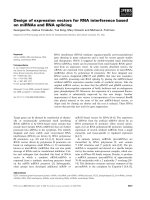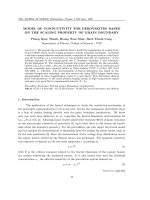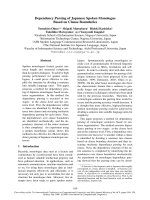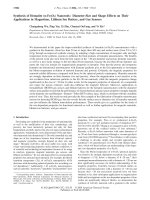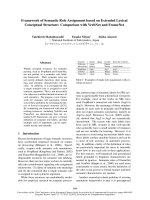Synthesis of branched conjugated copolymers based on triphenylamine and 3-hexylthiophene units
Bạn đang xem bản rút gọn của tài liệu. Xem và tải ngay bản đầy đủ của tài liệu tại đây (13.29 MB, 6 trang )
<span class='text_page_counter'>(1)</span><div class='page_container' data-page=1>
<i>DOI: 10.22144/ctu.jen.2017.011 </i>
<b>SYNTHESIS OF BRANCHED CONJUGATED COPOLYMERS BASED ON </b>
<b>TRIPHENYLAMINE AND 3-HEXYLTHIOPHENE UNITS </b>
Nguyen Trung Thanh1<sub>, Nguyen Thu Anh</sub>3<sub>, Nguyen Thi Le Thu</sub>1<sub>, Nguyen Ha Tran</sub>1,2
<i>1<sub>Faculty of Materials Technology, Vietnam National University, Vietnam </sub></i>
<i>2<sub>Materials Technology Key Laboratory, Vietnam National University, Vietnam </sub></i>
<i>3<sub>National Key Lab of Polymer and Composite Materials, Viet Nam National University, Vietnam </sub></i>
<b>Article info. </b> <b> ABSTRACT </b>
<i>Received date: 12/12/2015 </i>
<i>Accepted date: 30/03/2017</i> <i><b> The branched conjugated copolymer based on triphenylamine and 3-</b>hexylthiophene has been synthesized via Suzuki polycondensation </i>
<i>reac-tion in the presence of Pd(PPh3)4 and K2CO3 as catalytic system. This </i>
<i>conjugated polymer named </i>
<i>poly(triphenylamine-branched-3-hexylthiophene) (P(TP-b-3HT)). The reaction was carried out at 100°C in </i>
<i>24 hours in the toluene media. The average molecular weight of obtained </i>
<i>conjugated polymers was 24000 g/mol by gel permeation </i>
<i>chromatog-raphy (GPC) with polydispersity index of 1.8 The structure of </i>
<i>P(TP-b-3HT) was determined by 1<sub>H NMR and FTIR spectrum, and optical </sub></i>
<i>prop-erties of obtained conjugated polymer was characterized via UV-Vis. </i>
<i><b>Keywords </b></i>
<i>Hyperbranched conjugated </i>
<i>polymers, Polymeric solar </i>
<i>cells, Suzuki </i>
<i>polycondensa-tion </i>
Cited as: Thanh, N. T., Anh N. T., Thu, N. T. L., Tran, N. H., 2017. Synthesis of branched conjugated
copolymers based on triphenylamine and 3-hexylthiophene units. Can Tho University Journal of
<i>Science. Vol 5: 95-100. </i>
<b>1 INTRODUCTION </b>
The discovery of synthetic chemical materials in
the field of organic electronics has created a wealth
of functional conjugated organic materials, among
which π-conjugated polymer semiconductors are of
broad interest for applications in organic
electron-ics and optoelectronelectron-ics, including light-emitting
diodes, chemo-and biosensors, field-effect
<i>transis-tors and photovoltaic cells (Agrawal et al., 1993; </i>
<i>McCulloughet al., 1993; Chen et al., 1995; Bao et </i>
<i>al., 1996; Sirringhaus et al., 1998). Conjugated </i>
polymers containing 3-hexylthiophene, and
tri-phenylamine in the main chain or side chain have
received much attention because of their unique
properties derived from those units. These
materi-als exhibited as great organic semiconductors
which can be used as hole transporting materials in
<i>thin layer electro-optical devices (Chen et al., </i>
<i>1995; Pan et al., 2007; Li et al., 2007; Lim et al., </i>
<i>2011; Chen et al., 2013; Ma et al., 2013). </i>
Conse-quently, incorporation of 3-hexylthiophene or
</div>
<span class='text_page_counter'>(2)</span><div class='page_container' data-page=2>
branched structure can effectively suppress
aggre-gation and thus are restricted from aggregate based
fluorescence quenching. The development of
hy-perbranched polymeric and oligomeric materials
based on conjugated monomers has achieved
<i>sig-nificant progress. Qu et al. (2007) reported the </i>
syn-thesis of solvent-soluble hyperbranched polymers
based on carbazole and triphenylamine with
num-ber average molecular weights (Mn) ranging from
3,500 to 21,000 g/mol via polycondensation of
diethynylcarbazoles with tris (4-iodophenyl)
amine. Li <i>et al. </i> (2007) synthesized
hyperbranched polymers with precise conjugated
lengths by polycondensation of AB2 monomers
such as 1-(2-(3,5-dibromophenyl) ethynyl)-2,5-bis
(dodecyloxy)-4-ethynylbenzene and
1-(2-(4-(2-(3,5-dibromophenyl) ethynyl)-2,5- bis
(do-decyloxy) phenyl) ethynyl)-2,5-bis(do(do-decyloxy)-4-
ethynyl)-2,5-bis(dodecyloxy)-4-ethynylbenzene. Regarding to hyperbranched
<i>con-jugated oligomers, Wang et al. (2010) reported a </i>
series of hyperbranched molecules with 1,3,5-
tri-phenylbenzene as cores with different connecting
groups. These molecules exhibited a good
solubili-ty and film formation abilisolubili-ty, thermal stabilisolubili-ty as
well as necessary physical and chemical properties
for use in light-emitting diode (LED) devices.
Here in this paper, it is to report the synthesis of
conjugated polymers of 3- hexylthiophene linked
<i>with triphenylamine units, named as P(TP-b-3HT) </i>
as illustrated in Figure 1. The optical and the
nanostructures of the obtained hyperbranched
con-jugated polymers were characterized, and the effect
of polymer aggregation on the optical properties
was investigated.
<b>2 MATERIALS AND METHODS </b>
<b>2.1 Materials </b>
3-Hexylthiophene was purchased from TCI
(To-kyo, Japan). Triphenylamine, tetrahydrofuran
<i>(99.9%) and N-bromosuccinimide were purchased </i>
from Acros Organics. Tetrakis
(tri-phenylphosphine) palladium (0) Pd(PPh3)4 (99%)
and 4,4,4′,4′,5,5,5′,5′-octamethyl-2,2′-bi
(1,3,2-dioxaborolane) were purchased from
Sigma-Aldrich. Potassium acetate (KOAc), sodium
car-bonate (99%) and magnesium sulfate (98%) were
purchased from Acros and used as received.
Chlo-roform (CHCl3, 99.5%), toluene (99.5%) and
tetra-hydrofuran (THF, 99 %) were purchased from
Fisher/Acros and dried using molecular sieves
un-der N2. Dichloromethane (99.8%), n-heptane
(99%), methanol (99.8%), ethyl acetate (99%) and
diethyl ether (99%) were purchased from
Fish-er/Acros and used as received.
<b>2.2 Characterization </b>
1<sub>H NMR spectra were recorded in deuterated </sub>
chlo-roform (CDCl3) with TMS as an internal reference,
on a Bruker Avance 300 MHz. Fourier transform
infrared (FT-IR) spectra, collected as the average
of 64 scans with a resolution of 4 cm-1<sub>, were </sub>
rec-orded from KBr disk on the FT-IR Bruker Tensor
27.
Size exclusion chromatography (SEC)
measure-ments were performed on a Polymer PL-GPC 50
gel permeation chromatograph system equipped
with an RI detector, with tetrahydrofuran as the
eluent at a flow rate of 1.0 mL/min. Molecular
weight and molecular weight distribution were
calculated regarding to polystyrene standards.
UV–vis absorption spectra of polymers in solution
and polymer thin films were recorded on a
Shi-madzu UV-2,450 spectrometer over a wavelength
range of 300–700 nm at the room temperature.
<b>2.3 Synthesis of 2,5-dibromo-3-hexylthiophene </b>
<i>3-Hexylthiophene (5 g, 29.7 mmol) and </i>
N-bromosuccinimide (10.59 g, 59.5 mmol) were
add-ed to anhydrous THF (50 mL) at 0°C under
nitro-gen. The mixture was stirred at 50°C for 2.5 h.
Then, 10% aqueous Na2S2O3 was added, and the
mixture was extracted with diethyl ether and dried
over anhydrous MgSO4. The solvent was
evaporated to obtain the crude product, which was
purified by silica column chromatography (eluent:
<i>n-heptane) </i> to give pure
2,5-dibromo-3-hexylthiophene as a pale-yellow oil (7.3 g, Rf = 0,8,
Yield: 80%).
1<sub>H NMR (300MHz,CDCl3), (ppm): 6.97 (s, 1H), </sub>
2.52 (t, 2H), 1.56 (q, 2H), 1.32 (m, 6H), 0.89 (t,
3H).
<b>2.4 Synthesis of 2,2-(3-hexylthiophene-2,5-diyl) </b>
<b>bis(4,4,5,5-tetramethyl-1,3,2-dioxaborolane) </b>
</div>
<span class='text_page_counter'>(3)</span><div class='page_container' data-page=3>
as the crude product. The crude product was
<i>puri-fied over silica column with n-heptane/diethyl </i>
ether (v/v=9.5/0.5) as eluent to obtain a yellow
liquid as the pure product of
2,2′-(3-hexylthiophene-2,5-diyl)
bis(4,4,5,5-tetramethyl-1,3,2-dioxaborolane) (Rf = 0.4. Yield: 40%).
<b>2.5 Synthesis of tris (4-bromophenyl)amine </b>
<i>N-bromosuccinimide (2.17 g, 12.2 mmol) and </i>
tri-phenylamine (1 g, 4.08 mmol) were added to
an-hydrous THF (10 mL) at 0°C under nitrogen. The
mixture was stirred at 50°C for 1.5 h. After
com-pletion of the reaction, 10 mL of distilled water
was added to the reaction mixture, which was
ex-tracted with dichloromethane. The organic layer
was washed with 10% solution of Na2S2O3 and
10% solution of KOH, dried over anhydrous
MgSO4 and concentrated. The product was
<i>precipi-tated in cold n-heptane and dried under vacuum to </i>
give a white powder (Rf = 0.6; Yield: 67%).
1<sub>H NMR (300 MHz, CDCl3), δ (ppm): 7.35 (d, </sub>
6H), 6.95 (d, 6H).
<b>2.6 </b> <b>Synthesis of hyperbranched polymer based </b>
<b>on 3-hexylthiophene and triphenylamine </b>
<b>moieties (</b><i><b>P(TP-b-3HT)) </b></i>
200 mg (0.476 mmol) of
2,2′-(3-hexylthiophene-2,5-diyl)
bis(4,4,5,5-tetramethyl-1,3,2-dioxaborolane) and 150 mg of (0.311 mmol)
tris(4-bromophenyl) amine were dissolved in 5.7 mL of
toluene. To the solution, 328 mg (2.38 mmol) of
potassium carbonate (K2CO3) was added to the
monomer solution. Then 1.2 mL of ethanol (EtOH)
and 1 mL of distilled water were introduced to the
solution. The mixture was bubbled with N2 for 30
min, followed by addition of 55 mg of Pd(PPh3)4.
The reaction was carried out at 100°C for 72 h.
After completion of the reaction, the mixture was
extracted with CHCl3. The obtained organic layer
was passed through Celite to remove the Pd
cata-lyst and the insoluble polymer fraction,
subse-quently washed with 10% solution of Na2S2O3 and
distilled water, dried over Na2CO3, concentrated
<i>and finally poured into a large amount of cold </i>
n-heptane to precipitate the polymer. The resulting
polymer was isolated by filtration, washed with
acetone to remove oligomers and finally dried
un-der reduced pressure at 50°C for 24 h. A yield of
57% was obtained.
1<sub>H NMR (300 MHz, CDCl3), δ (ppm): 7.63 (broad, </sub>
2H), 6.95-7.39 (broad, 3H), 2.51 (t, 2H), 1.2-1.61
(broad, 8H), 0.89 (t, 3H). FT-IR (cm-1<sub>): 3059, </sub>
2917, 2851, 1584, 1560, 1490, 1436, 1319, 1274,
1183, 1117, 1011, 825, 753, 721, 696, 628, 542.
<b>3 RESULTS AND DISCUSSION </b>
The chemical structures of hyperbranched
polymers <i><b>P(TP-b-3HT) </b></i>are shown in Figure 1.
The monomers used include
2,2′-(3-hexylthiophene-2,5-diyl)
bis(4,4,5,5-tetramethyl-1,3,2-dioxaborolane) (1, Fig. 1) and
tris(4-bromophenyl) amine (2, Fig. 1). These monomers
underwent Suzuki polycondensation to build
hy-perbranched polymer structures, which was carried
out in a biphasic mixture of toluene and aqueous
K2CO3 with Pd(PPh3)4 as the catalyst at reflux
temperature.
<b>Fig. 1: Polycondensation of 2,2-(3-hexylthiophene-2,5-diyl) </b>
<b>bis(4,4,5,5-tetramethyl-1,3,2-dioxaborolane) and tris(4-bromophenyl) amine monomers for synthesis of </b><i><b>P(TP-b-3HT) </b></i>
The <i><b>P(TP-b-3HT)</b></i> hyperbranched polymer was
</div>
<span class='text_page_counter'>(4)</span><div class='page_container' data-page=4>
accom-panying the appearance of a solvent-insoluble
black solid. After 72 h, the hyperbranched polymer
was obtained by purification via extraction, catalyst
removal, washing and precipitation. The number
average molecular weights (Mn) as determined by
GPC relative to polystyrene standards of <i><b></b></i>
<b>P(TP-b-3HT) </b>were 24000 g/mol, with polydispersities of
1.8 (Fig. 2). This hyperbranched conjugated
poly-mers were soluble in common organic solvents
such as chloroform, THF, toluene and insoluble in
<i>acetone, methanol and n-heptane. The polymer </i>
structures were characterized by transmission
FT-IR and 1<sub>H NMR spectroscopies. The FT-IR spectra </sub>
(Fig. 3) of <i><b>P(TP-b-3HT)</b></i> displayed several bands
between 2850 and 3060 cm-1<sub> due to CH stretching </sub>
<i>modes of n-hexyl groups and ring C-H stretching </i>
vibrations. The bands at 1584/1585 cm-1<sub> and </sub>
1490/1492 cm-1<sub> are ascribed to the aromatic C=C </sub>
stretching and aromatic C-H deformation
vibra-tions, respectively, while the bands at 1319/1323
cm-1<sub> and 1273/1274 cm</sub>-1<sub> are assigned to the C-N </sub>
stretching of triphenylamine units.
<b>Fig. 2: GPC trace of </b><i><b>P(TP-b-3HT)</b></i>
<b>Fig. 3: FT-IR spectrum of </b><i><b>P(TP-b-3HT)</b></i>
In the 1<sub>H NMR spectrum of hyperbranched </sub>
poly-mer <i><b>P(TP-b-3HT)</b></i> (Fig. 4), a signal was observed
7.63 ppm assignable to the aromatic protons of
triphenylamine ring which was originally at 7.35
ppm for the tris(4- bromophenyl) amine monomer.
Moreover, the 1<sub>H NMR spectrum of </sub><i><b><sub>P(TP-b-3HT) </sub></b></i>
</div>
<span class='text_page_counter'>(5)</span><div class='page_container' data-page=5>
<b>Fig. 4: 1<sub>H NMR spectrum of </sub></b><i><b><sub>P(TP-b-3HT)</sub></b></i>
<i>Figure 5 depicts the UV–vis spectra of </i>
P(TP-b-3HT), measured in different solvents including
CHCl3, THF, toluene and in solid state films. The
<i>P(TP-b-3HT) solutions showed an absorption </i>
max-imum at 340 nm attributable to triphenylamine and
3-hexylthiophene moieties. The solid film of
<i>P(TP-b-3HT) also showed a similar absorption behavior </i>
with an absorption maximum at 350 nm. This
<i>indi-cates the low aggregation degree of P(TP-b-3HT) </i>
hyperbranched chains in the thin film state.
<b>Fig. 5: UV-Vis of </b><i><b>P(TP-b-3HT) </b></i>
<b>4 CONCLUSION </b>
In this article, the synthesis of a novel
hyper-branched conjugated polymers containing
tri-phenylamine linked with 3-hexylthiophene
<i>(P(TP-b-3HT)) is demonstrated. The hyperbranched </i>
pol-ymers with solvent-soluble properties and Mn of
24000 g/mol were successfully obtained by Suzuki
polycondensation of
</div>
<span class='text_page_counter'>(6)</span><div class='page_container' data-page=6>
<b>ACKNOWLEDGMENTS </b>
This research was supported by the project
“C2015-20-24” from Ho Chi Minh City University
of Technology - Vietnam National University – Ho
Chi Minh City, 268 Ly Thuong Kiet, District 10,
Ho Chi Minh City 70000, Viet Nam.
<b>REFERENCES </b>
Agrawal, A.K., Jenekhe, S.A., 1993. Synthesis and
pro-cessing of heterocyclic polymers as electronic,
op-toelectronic, and nonlinear optical materials. 2 New
series of conjugated rigid-rod polyquinolines and
polyanthrazolines. Macromolecules. 26: 895–905.
Bao, Z., Dodabalapur, A., Lovinger, A.J., 1996. Soluble
and processable regioregular poly
(3-hexylthiophene) for thin film field-effect transistor
applications with high mobility. Applied Physics
Letters. 69: 4108–4110.
Bharathi, P., Moore, J.S., 2000. Controlled synthesis of
hyperbranched polymers by slow monomer addition
to a core. Macromolecules. 33: 3212–3218.
Bo, Z., Schluter, A.D., 2003. “AB2 + AC2” approach to
hyperbranched polymers with a high degree of
branching. Chemical Communications. 2354–2355.
Chen, L., Li, X., Ying, W., Zhang, X., Guo, F., Li, J.,
Hua, J., 2013. 5,6-Bis(octyloxy) benzo [c] [1,2,5]
thiadiazole-bridged dyes for dye-sensitized solar
cells with high open-circuit voltage performance.
Eu-ropean Journal of Organic Chemistry. 1770–1780.
Chen, T.A., Wu, X., Rieke, R.D., 1995. Regiocontrolled
synthesis of poly (3-alkylthiophenes) mediated by
Rieke zinc: their characterization and solid-state
properties. Jounral of American Chemistry Society.
117: 233–244.
Li, J., Sun, M., Bo, Z., 2007. Synthesis of hyperbranched
polymers with precise conjugation length. Journal of
Polymer Science Part A: Polymer Chemistry. 45:
1084–1092.
Li, Y., Wu, Y., Liu, P., Birau, M., Pan, H., Ong, B.S.,
2006. Poly (2,5-bis (2- thienyl)-3,6-dialkylthieno
[3,2-b] thiophene)s-High-mobility semiconductors
for thin-film transistors. Advanced Materials. 18:
3029–3032.
Lim, Z.B., Xue, B., Bomma, S., Li, H., Sun, S., Lam,
Y.M., Belcher, W.J., Dastoor, P.C., Grimsdale, A.C.,
2011. New moderate bandgap polymers containing
alkoxysubstituted-benzo [c] [1,2,5] thiadiazole and
thiophene-based units. Journal of Polymer Science
Part A: Polymer Chemistry. 49: 4387–4397.
Ma, F., Shi, W., Mi, H., Luo, J., Lei, Y., Tian, Y., 2013.
Triphenylamine-based conjugated polymer/I−complex
as turn-on optical probe for mercury (II) ion.Sensors
and Actuators B Chemical. 182: 782–788.
McCullough, R.D., Tristram-Nagle, S., Williams, S.P.,
Lowe, R.D., Jayaraman, M., 1993. Self-orienting
head-to-tail poly (3-alkylthiophenes): new insights
on structure–property relationships in conducting
polymers. Journal of American Chemistry Society.
115: 4910–4911.
Obson, J.H., Kenwright, M., 1997. A simple ‘one pot’
route to the hyperbranched analogues of Tomalia's
poly (amidoamine) dendrimers. Chemical
Commu-nications: 1877–1879.
Pan, H., Wu, Y., Li, Y., Liu, P., Ong, B.S., Zhu, S., Xu,
G., 2007. Benzodithiophene copolymer-A
low-temperature, Solution-processed high-performance
semiconductor for thin-film transistors.
Advanced-Functional Materials. 17: 3574–3579.
Qu, J., Shiotsuki, M., Kobayashi, N., Sanda,F., Masuda,
T., 2007. Synthesis and properties of carbazole-based
hyperbranched conjugated polymers. Polymer. 48:
6481–6490.
Sirringhaus, H., Tessler, N., Friend, R.H., 1998.
Inte-grated optoelectronic devices based on conjugated
polymers. Science. 280: 1741–1744.
Smet, M., Schacht, E., Dehaen, W., 2002. Synthesis,
characterization, and modification of hyperbranched
poly (arylene oxindoles) with a degree of branching
of 100 %. Angewandte Chemie International Edition.
41: 4547–4550.
</div>
<!--links-->

